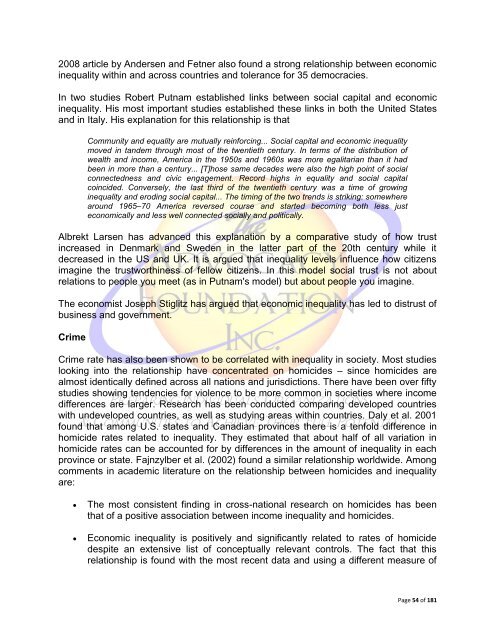Create successful ePaper yourself
Turn your PDF publications into a flip-book with our unique Google optimized e-Paper software.
2008 article by Andersen and Fetner also found a strong relationship between economic<br />
inequality within and across countries and tolerance for 35 democracies.<br />
In two studies Robert Putnam established links between social capital and economic<br />
inequality. His most important studies established these links in both the United States<br />
and in Italy. His explanation for this relationship is that<br />
Community and equality are mutually reinforcing... Social capital and economic inequality<br />
moved in tandem through most of the twentieth century. In terms of the distribution of<br />
wealth and income, America in the 1950s and 1960s was more egalitarian than it had<br />
been in more than a century... [T]hose same decades were also the high point of social<br />
connectedness and civic engagement. Record highs in equality and social capital<br />
coincided. Conversely, the last third of the twentieth century was a time of growing<br />
inequality and eroding social capital... The timing of the two trends is striking: somewhere<br />
around 1965–70 America reversed course and started becoming both less just<br />
economically and less well connected socially and politically.<br />
Albrekt Larsen has advanced this explanation by a comparative study of how trust<br />
increased in Denmark and Sweden in the latter part of the 20th century while it<br />
decreased in the US and UK. It is argued that inequality levels influence how citizens<br />
imagine the trustworthiness of fellow citizens. In this model social trust is not about<br />
relations to people you meet (as in Putnam's model) but about people you imagine.<br />
The economist Joseph Stiglitz has argued that economic inequality has led to distrust of<br />
business and government.<br />
Crime<br />
Crime rate has also been shown to be correlated with inequality in society. Most studies<br />
looking into the relationship have concentrated on homicides – since homicides are<br />
almost identically defined across all nations and jurisdictions. There have been over fifty<br />
studies showing tendencies for violence to be more common in societies where income<br />
differences are larger. Research has been conducted comparing developed countries<br />
with undeveloped countries, as well as studying areas within countries. Daly et al. 2001<br />
found that among U.S. states and Canadian provinces there is a tenfold difference in<br />
homicide rates related to inequality. They estimated that about half of all variation in<br />
homicide rates can be accounted for by differences in the amount of inequality in each<br />
province or state. Fajnzylber et al. (2002) found a similar relationship worldwide. Among<br />
comments in academic literature on the relationship between homicides and inequality<br />
are:<br />
<br />
<br />
The most consistent finding in cross-national research on homicides has been<br />
that of a positive association between income inequality and homicides.<br />
Economic inequality is positively and significantly related to rates of homicide<br />
despite an extensive list of conceptually relevant controls. The fact that this<br />
relationship is found with the most recent data and using a different measure of<br />
Page 54 of 181

















